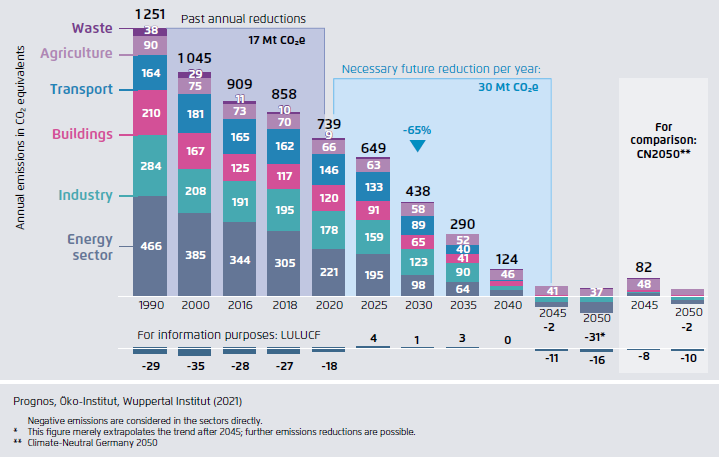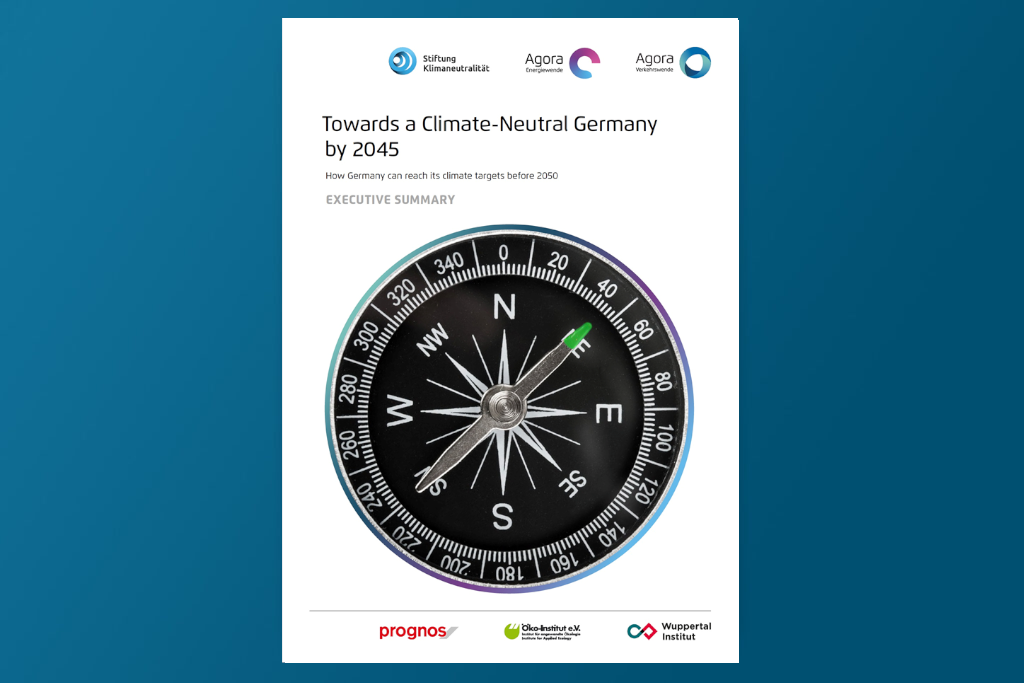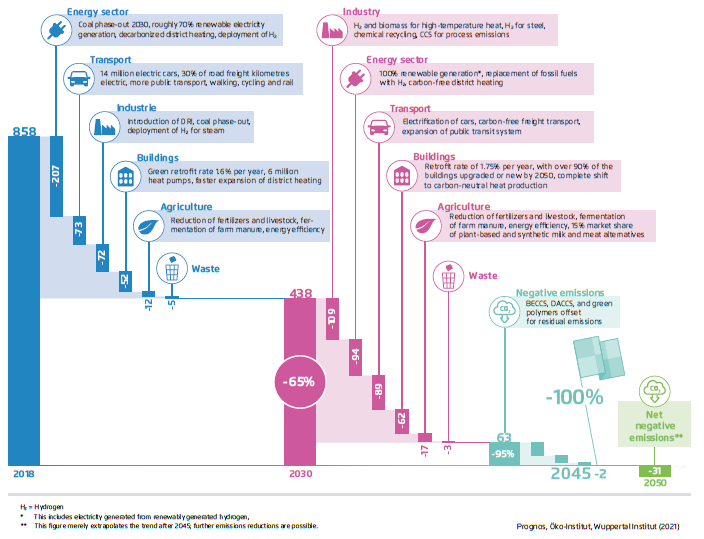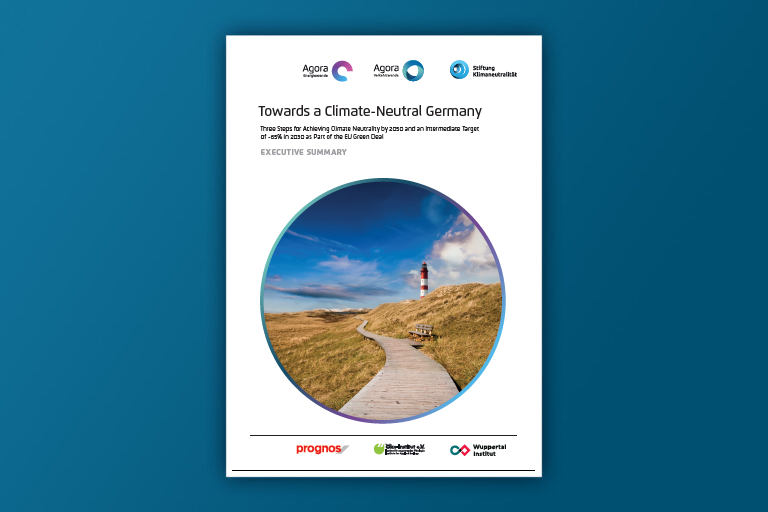The Paris Agreement adopted by world governments at the end of 2015 sets the goal of limiting global warming to well below 2 °C and to pursue efforts to limit the increase to 1.5 °C.
To achieve this, the amount of greenhouse gases emitted globally in the future need to be greatly reduced. The Paris Agreement is intended to ensure that annual global emissions are reduced as fast as possible, thereby stretching the remaining carbon budget and reducing greenhouse gas emissions to net zero in only a few decades.
Both the EU and Germany have committed themselves to achieving climate neutrality by no later than 2050.
With this study, published on April 26, 2021, we have shown that Germany can also achieve climate neutrality five years earlier and could thus reduce greenhouse gas emissions by a further billion tons.
Study “Towards a Climate-Neutral Germany 2045”
How can Germany succeed in creating an economy that does not rely on coal, oil and gas? And what is required for the next ten years? In a large-scale scientific study, we have commissioned a study in cooperation with other think tanks to investigate how Germany can become climate-neutral.
The study develops scenarios that show how Germany can become climate-neutral by 2045, with cost-effectiveness, adherence to existing investment cycles and acceptance as core criteria.
The scenarios show that this is possible through the consistent application of technologies that are already available today or are well developed. Climate neutrality requires an electricity system based entirely on renewable energies. Road transport and heat supply will largely switch to electricity-based solutions. The efficient refurbishment of existing buildings and the establishment of a hydrogen economy for industry, power generation, shipping and aviation are essential. As a result, by 2045 Germany will have a renewed electricity and transport infrastructure, a sustainable hydrogen industry, a modern building stock and an industry that is at the forefront of future technologies in global competition. Tackled wisely, the path to climate neutrality can become a comprehensive investment and modernization program.
The previous study, Towards a Climate-Neutral Germany 2050, describes how the target set by the German parliament can be achieved by the middle of the century. With the present study, we show that climate neutrality is also possible as early as 2045. This once again significantly reduces the total greenhouse gas emissions released.
Prognos, Öko-Institut, Wuppertal Institut (2021): Towards a Climate-Neutral Germany by 2045. How Germany can reach its climate targets before 2050. Executive Summary conducted for Stiftung Klimaneutralität, Agora Energiewende and Agora Verkehrswende.
Key findings
1. Germany can achieve climate neutrality by 2045 in three steps while adhering to existing investment cycles. The first step consists of a 65% reduction in emissions by 2030. The second step is the complete transition to climate-neutral technologies, for a total emissions reduction of 95%. The third step is the offsetting of residual emissions through carbon capture and storage.
2. The path to climate neutrality involves a comprehensive investment program comparable in scope to the German economic miracle of the 1950s and 60s. The core elements of the program are the creation of a renewable-based energy sector, mass electrification, a smart and efficient modernization of buildings and the development of a hydrogen economy for the industrial sector. Besides achieving climate neutrality, the program will also improve people’s quality of life by reducing noise and air pollution.
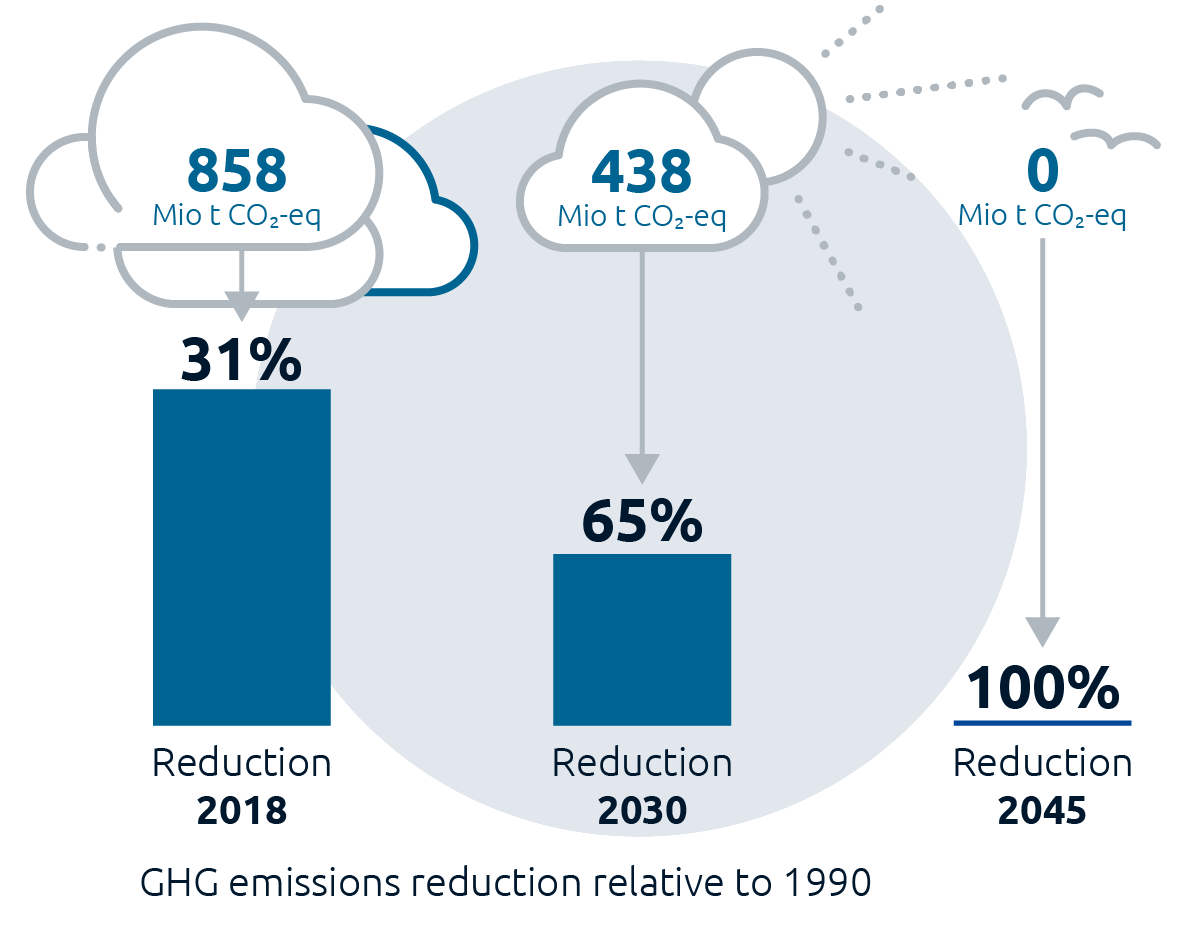
3. An enhanced German reduction target of 65% for 2030, in line with the requirements of the European Green Deal, will require significantly accelerating the green transition in the energy, transport and heating sectors. This includes the complete phase-out of coal by 2030, a 70% share of renewables in electricity generation, 14 million electric cars on the road, 6 million heat pumps, an increase in the green retrofit rate of at least 50% and the use of some 60 TWh of clean hydrogen.
4. The next legislative period will determine how Germany goes about achieving climate neutrality by 2045 and a 65% reduction in GHG emissions by 2030. Government action after the 2021 federal election will be pivotal for future climate policy. Intelligent policy instruments will be needed to modernize Germany’s economy and make it sustainable and resilient. They will also be needed to ensure that the structural changes are as fair and inclusive as possible.
Infographic: GHG emissions by sector (in German)
Prognos, Öko-Institut, Wuppertal Institut (2021)
PDF-file
Infographic: Policy measures to achieve climate neutrality in 2045
Prognos, Öko-Institut, Wuppertal Institut (2021)
PDF-file
Would the path described in the study allow to meet the goals of the Paris Climate Convention?
Yes!
As a nation state, Germany has ratified the Paris Agreement and thus committed itself to the according climate goals (“Limiting global warming to well below 2 degrees and to pursue efforts to limit the increase to 1.5 degrees”). At the same time, the European Union, of which Germany is the largest member state, has also ratified the agreement.
However, only the EU as a group on behalf of all its member states has made a reduction commitment under the agreement (NDC).
In the Paris Agreement, it was agreed that the signatory states would review their reduction contributions for 2030 every five years, starting in 2020. In a first step, the EU decided already at the end of 2019 to become the first climate-neutral continent by 2050. The European Climate Law, on which the EU Parliament and EU member states reached political agreement on April 21, 2021, commits the EU to achieving climate neutrality by 2050 and, as an interim target, to reducing its net greenhouse gas emissions by at least 55% from 1990 levels by 2030.
An interim target for 2030 of 55% and climate neutrality in Europe by 2050 do not suffice to limit global warming to 1.5 degrees, yet at least to well below 2 degrees. This assumption presupposes that all other signatory states also meet their responsibilities in a comparable manner.
The EU will only be able to meet an increased interim target for 2030 and thus its obligations under the Paris Convention if all its Member States make a fair contribution. What “fair” in this context means will ultimately be decided by the EU institutions. We assume Germany’s contribution to be 65% GHG reductions by 2030.
If Germany achieves climate neutrality as early as 2045, this would save the atmosphere another billion tons of greenhouse gas emissions.
Three steps to climate neutrality by 2045
Step 1 – Reduce emissions by 65% by 2030
An important step to climate neutrality by 2045 is a 65 percent reduction of emissions by 2030. Actions taken in the 2020s will decide whether climate neutrality can be achieved by the middle of the century. Raising the EU reduction target for 2030 from 40 to 55 percent will also require a contribution from Germany in the order of 65 percent.
The 2019 Climate Protection Act provides a solid foundation for a further reduction in emissions. The additional reduction potentials relative to previous targets vary across sectors, and some are harder to realize than others. According to the calculations in this study, further reductions in the agriculture and waste sectors are very unlikely, while in the transport and building sectors, additional cuts of 5 Mt each are possible. The greatest potential reductions are in the industry and energy sectors, at 17 Mt and 77 Mt, respectively.
The energy sector has the potential to cut emissions by 207 Mt CO₂eq by 2030, or 77 Mt CO₂eq more than the sector target established in the Climate Protection Act. The primary means for achieving the additional reductions is an accelerated phase-out of coal (2030 instead of 2038) and the increased expansion of renewable capacity in electricity generation. The use of hydrogen for fueling power stations and CHP plants starting in the late 2020s will also contribute to the decline. A phase-out of coal by 2030 will likely occur in the context of tightened EU reduction targets (from 40 to 55%) and adjustments to the EU ETS, largely due to the changing market conditions for coal-fired power generation.
Growing electrification in all sectors will increase electricity consumption by 51 TWh, or 9%, relative to 2018. In 2030, renewable energy will make up around 70% of gross electricity consumption. This will require increasing capacities in offshore wind to 25 GW, in onshore wind to 80 GW and in PV to 150 GW.
Meeting climate targets in the industrial sectors will require the introduction of new processes in the basic materials industry. Over the next 10 years, around 50% of the central plants in the German basic materials industry are scheduled for modernization. This gives Germany a good opportunity to introduce new technologies without stranding assets. The steel industry in particular could be a pioneer in this regard. Its old blast furnaces could be replaced by direct reduction systems fueled mainly by hydrogen and smaller proportions of natural gas.
Investment in new technologies based on electricity or (mainly) renewably produced hydrogen is required in other sectors as well. The creation of an accompanying infrastructure is needed not only for industrial hydrogen supply but also for CCS in the cement and lime industries. Moreover, it is important that German industry invest quickly in more recycling and in increased quantities of secondary raw materials so that these solutions can exploit their full potential after 2030. The first CCS systems in the cement industry could be operational as early as 2030.
In the building sector, the additional reductions can be achieved through changes in heating systems, an expansion of heating networks and around a 50% increase in the green retrofit rate. Among new heating installations, heat pumps will gain a large market share by the mid-2020s, particularly for single- and two-family homes, leading to a total of 6 million heat pumps by 2030. Green district heating will gain increasing importance in urban areas. After 2025, new heating systems fueled by heating oil or natural gas may only be used in exceptional cases.
In the transport sector, there is a change in current trends. People stay as mobile as before, but they use public transport, cycle or walk significantly more. In 2030 there will be 14 million electric cars (including plug-in hybrids) on the road. Rail will be used to transport a larger volume of goods, while one-third of road freight kilometers will be covered by electric trucks powered by batteries, overhead lines and fuel cells.
By 2030, the agricultural sector will have implemented available mitigation measures such as the fermentation and improved storage of farm manure and the use of low-emission muck spreaders. Additional reductions will be achieved through changes in agricultural production, including the expansion of organic farming, the switch to crops with lower nitrogen requirements and the reduction of livestock. The changes in production reflect changes in demand as people consume fewer animal products and the sector shifts from gaseous to solid biofuels.
In the waste sector, methane emissions from landfills will continue to decrease through 2030. The reduction of methane emissions will be accelerated by expanding landfill ventilation measures. Other areas in the sector have little potential for reductions by 2030.
Step 2 – Reduce emissions by 95%
With the measures outlined, two-thirds of the necessary GHG savings to climate neutrality can be achieved from 1990 to 2030. For the last third, the paths taken must be pursued consistently and rapidly after 2030 so that the goal can be achieved as early as 2045. Compared to the study Towards a Climate-Neutral Germany 2050, which assumed a period of 20 years for this last step, the time available is reduced by a quarter. Measures must therefore be implemented more quickly, new technologies, drives and processes must be deployed more quickly and the necessary new infrastructure must be made available more quickly.
With these increased efforts, achieving CO₂ neutrality as early as 2043 and climate neutrality by avoiding or offsetting all greenhouse gas emissions in 2045 are possible. If the trends in measures are continued beyond 2045, the net negative emissions that then arise will support global climate protection. Across sectors, the trend toward electrification accelerates by 2045 compared with the study Towards a Climate-Neutral Germany 2050, and hydrogen also gains importance earlier as a secondary energy carrier and raw material. On the other hand, the shorter time frame creates additional pressure on the efficiency improvements needed to reduce emissions in all sectors. However, efficiency measures can only be accelerated at greater expense than supply-side measures. As a result, electricity demand will increase faster and more strongly, and CCS, i.e., CO₂ capture and storage, will also have to take on a stronger role. The role of solid biomass remains important in areas with process-related carbon fluxes and very concentrated energy demand at sites suitable for CCS (mainly chemical and steel industries).
In detail, the following developments are necessary up to climate neutrality in 2045 in the individual sectors:
In the energy sector, renewable energies are expanded more strongly and faster. Electricity consumption grows by 60 percent to about 1,000 terawatt-hours from 2030 to 2045, mainly due to further electrification as well as increasing hydrogen production. The focus of RE expansion after 2030 continues to be on wind energy and photovoltaics. Hydrogen gains increasing importance and replaces natural gas as the main energy source for residual power generation after 2040. In 2045, electricity and district heating generation will be completely CO₂-free. Compared with the results of the study Towards a Climate-Neutral Germany 2050, gross electricity consumption in 2045 thus increases by around 130 terawatt hours; in 2050, the increase is still 40 terawatt hours. The higher electricity consumption in 2045 results, on the one hand, from the faster electrification of the other sectors and, on the other hand, from the higher hydrogen demand, which is generated domestically to limit imports. In addition, lower energy efficiency progress in the various areas of application can also be expected in the shorter period. Here, the scenario explicitly relies on the accelerated ramp-up of climate protection technologies on the supply side, since a further acceleration of efficiency progress reaches its limits and consumption restrictions (sufficiency) were not assumed.
Therefore, to meet the electricity demand of climate neutrality already in 2045, a faster and stronger expansion of wind energy and photovoltaics is required in the years after 2030. The installed capacity of photovoltaic systems required in 2045 is 385 gigawatts. Compared with the year of comparison in the study Towards a Climate-Neutral Germany 2050, this represents an increase of 70 gigawatts. Wind power also requires even higher expansion corridors. For onshore wind power, a generation capacity of 145 gigawatts is required in 2045, and the expansion of offshore wind power to 70 gigawatts must be brought forward to 2045. Compared with the study Towards a Climate-Neutral Germany 2050, this means increases in installed capacity of 17 gigawatts on land and 9 gigawatts at sea in 2045. For offshore wind energy in particular, with its long planning periods, this acceleration represents a major challenge. For onshore wind energy and photovoltaics, the increased expansion will lead to rising land requirements.
In industry, the trend toward electricity and hydrogen and, in some cases, biomass as energy sources will continue, so that industry will be largely climate-neutral by 2040. Chemical raw materials (feedstocks) will also be successively replaced by chemical recycling and synthetic, non-fossil carbon-based feedstocks from as early as 2030. Compared to the study Towards a Climate-Neutral Germany 2050, the supply of the large heat requirements in the industrial sector with biomass will be accelerated. In parallel, the expansion of the CO₂ network in Germany also picks up speed more quickly from 2035 and can thus be completed by 2045. Between 2030 and 2040, industrial CO₂ sources with an annual capture volume of 30 million metric tons of CO₂ will be tapped into the CO₂ network, and by 2045 the annual volume stored will rise once again to 52 million metric tons. The current scenario does not take into account other options that could lead to an even earlier reduction in emissions. In the industrial sector, for example, emissions could fall more rapidly before 2040 due to a drop in demand for (and production of) energy-intensive goods. Also, reduced construction activity, especially in new buildings, would have a dampening effect on cement and steel demand, and more durable products would in turn have a mitigating effect on plastics demand.
In the building sector, renovations and the decline in consumption in new construction will accelerate after 2030. The average annual renovation rate based on the total housing stock increases to nearly 1.75 percent between 2030 and 2045. This is slightly higher than the 1.6 percent assumed in the Climate-Neutral Germany 2050 scenario for the period 2030 to 2050. The higher renovation rate succeeds in renovating or efficiently constructing more than 90 percent of the building area over time since 2000 by 2050. At the same time, the improvements in refurbishment efficiency in the existing stock and the increase in efficiency standards in new construction are slightly brought forward compared to the Climate-Neutral Germany 2050 scenario for the period after 2030.
After 2025, as in the Climate-Neutral Germany 2050 scenario, new fossil heat generators will only be installed in exceptional cases. In the current scenario, the operating life of fossil heat generators is also limited to 20 years. Compared to the Climate-Neutral Germany 2050 scenario, in which longer operating lives were also considered in the plant cohorts, this means a restriction, which, however, only has a minor impact on the de facto useful life of gas heating systems, since the phase-out of gas heating systems is supported by market effects anyway. Due to the strong reduction of gas heating in the building sector, the costs for the operation and maintenance of the gas networks are spread over fewer and fewer end customers. This makes the use of gas increasingly uneconomical for the remaining customers. It is to be expected that the operation of the distribution networks for natural gas will not be maintained if only a few customers are served, but that network sections will be successively shut down when the capacity utilization falls below a threshold. This leads to discontinuous declines in the number of connections in the individual networks: Acceleration due to the increase in the cost of network use, then abrupt decline when subnetworks are shut down. Since this development is not synchronous for all distribution networks, a more even development is seen when all gas connections are considered. Individual clusters may persist (longer), also due to the use of biomethane.
Through these measures and developments, most fossil heat generators will have been replaced in 2045. At the same time, the progressive installation of CO₂-free heating systems and the connection of buildings to heating grids will almost completely eliminate CO₂ emissions from the building sector except for a residual amount of 3 million metric tons of CO₂-eq. In 2050, only minor methane and nitrous oxide emissions from biomass use will then remain. Between 2030 and 2045, significantly more homes, namely 920,000, will be connected to a heat pump heating system on an annual average. This increases the total stock to 14 million heat pumps already in 2045 – in the Climate-Neutral Germany 2050 scenario, this stock will not be reached until 2050.
The current study did not take into account behavior-related reduction options that deviate from current trends. For example, per capita living space has increased significantly in recent years, and the current scenario also assumes such an increase.
In transport, overall passenger transport performance remains at about the current level, while freight transport performance continues to rise due to economic growth. Changes compared to the 2050 scenario mainly concern the speed of electrification. As early as 2032, no more passenger cars with combustion engines will be registered. By 2045, almost all existing vehicles with internal combustion engines will be replaced by e-cars. A residual stock of classic cars older than 30 years will remain on the roads. Road freight transport will also be operated almost exclusively with battery-electric, overhead line and fuel cell vehicles as early as 2045, as will bus and rail. Compared to the Climate-Neutral Germany 2050 scenario, the ramp-up of electricity-based fuels is accelerated. In 2035, for example, 20 percent of the final energy demand for inland waterway vessels will already be replaced, and in 2040 the figure will be 100 percent. The shares of electricity-based fuels in air and maritime transport already increase significantly after 2035, so that greenhouse gas neutrality is achieved in 2045. The higher cost of fuels, combined with other measures, ensures that transport demand growth in international aviation is dampened sooner.
In agriculture, significant reductions will be achieved by 2045 through the conversion of livestock and the fermentation of high proportions of farm manure in biogas plants. The most important change compared to the Climate Neutral Germany 2050 scenario lies in the assumption of increasing demand for plant-based and synthetic substitutes for meat and milk. This rises to a share of 15 percent of total consumption from 2031 to 2045. Dynamic development can already be observed for this market segment today (albeit at a low level), so such a rate of increase is more in the middle of the spectrum of expected developments. It is assumed that manufacturers will be able to further improve taste quality and that technical developments, economies of scale in production and competition in the market will reduce specific prices. Over the longer term, substitute products can be offered worldwide at lower market prices than natural products. Therefore, this scenario also assumes that the development will have an impact on foreign trade for meat and milk from Germany. By replacing 15 percent of natural meat and dairy products, the livestock numbers of all farm animals and the emissions from livestock farming will once again decrease significantly.
In the area of agricultural soils, the main reduction potential has already been tapped by 2030. However, after 2030, compared to the Climate-Neutral Germany 2050 scenario, there are still further reduction effects in the area of emissions from agricultural soils. For greenhouse gas neutrality as early as 2045, the mitigation measures must be implemented earlier or more quickly from 2030. This applies in particular to peatland rewetting, increasing organic farming and increasing non-productive land. The establishment of short-rotation plantations and usable wooded strips also takes place earlier and to a greater extent than in the Climate-Neutral Germany 2050 scenario. In addition to bringing forward the target year, the higher demand from industry for energy wood also has an effect here. Overall, this scenario results in a higher land requirement for extensification and biomass provision already in 2045 than in the Climate-Neutral Germany 2050 scenario. This land can be provided in time, as the declining livestock numbers result in a lower demand for forage land.
In the waste sector, residual emissions from landfilling, biological treatment and wastewater treatment remain in 2045. Due to biological processes, emissions from the waste sector cannot be completely avoided. Reductions are achieved in all areas by 2045. Compared to the Climate-Neutral Germany 2050 scenario, landfill aeration projects in the waste sector are brought forward and expanded in the years 2030 to 2040.
Step 3 – Offset residual emissions with CCS and negative emissions
Residual GHG emissions are the emissions that cannot be eliminated by mitigation measures. In the agricultural sector, these arise through biological processes in soils (fertilizers) and in animal husbandry. Residual emissions will also exist in industrial processes and waste management. By contrast, energy-related GHG emissions can be almost completely eliminated by using renewable energy sources. Only small amounts of methane and nitrous oxide emissions from the storage, transport and combustion of biomass and synthetic fuels will remain.
Total residual emissions will amount to 63 Mt CO₂eq in 2045, which corresponds to 5% of emissions in 1990. The remaining emissions will be offset primarily by biomass CCS, direct air carbon capture and storage and the absorption of CO₂ by green polymers. These technologies capture CO₂ directly or indirectly from the atmosphere and place it in long-term storage.
Based on our calculations, these technologies create negative emissions that are somewhat greater than the remaining emissions, resulting in slightly negative total emissions.
- Bioenergy with carbon capture and storage (BECCS) is the capture and geological storage of CO₂ that is created from the combustion of biomass. Since biomass is largely CO₂-neutral when cultivated sustainably and used as a waste material, BECCS can remove CO₂ from the atmosphere in the long term. The use of BECCS is limited by the amount of sustainably available biomass.
- Direct Air Carbon Capture and Storage (DACCS) is the capture of CO₂ directly from the air and its subsequent storage in suitable geological formations. The ambient air is sucked in by fans and bound by a sorbent. The energy consumption and the costs of DACCS are significantly higher than for BECCS.
- Green naphtha / absorption of CO₂ to green polymers: Biomass or CO₂ absorbed from the air via direct air capture can be used in combination with renewables-based hydrogen in Fischer-Tropsch plants to create green naphtha and other bio-based hydrocarbons. These can then be processed into polymers and plastics. With an improved recycling system, the plastics can be permanently kept in the material cycle. Coupled with CCS for waste incineration, this technology can prevent the re-emission of captured carbon.
As a result of the earlier and increased use of these technologies and measures compared with the Climate Neutral Germany 2050 scenario, more CO₂ is already removed from the atmosphere in 2045 than is entered, i.e. net negative emissions occur. After 2045, residual emissions continue to decline and Direct-Air-Capture plants are further expanded. This results in Germany reaching a net emission level of minus 30 million metric tons CO₂-eq in 2050.
In addition to these technical measures, measures for the rewetting of peatlands in the Land Use, Land Use Change and Forestry (LULUCF) sector will be increased compared to the Climate Neutral Germany 2050 scenario. This will ensure that this sector remains a CO₂ sink in the long term. With an expansion of measures in the LULUCF sector, a sink of minus 11 million metric tons CO₂-eq is achieved in 2045, which increases to a value of minus 16 million metric tons CO₂-eq by 2050. However, the current sink level of minus 27 million tons CO₂-eq cannot be sustained. Natural sinks, i.e. carbon uptake by forests and soils, are also only reported in this study for information purposes and are not counted towards achieving the climate targets.
Study “Towards a Climate-Neutral Germany 2050”
October 2020
The large-scale study “Towards a Climate-Neutral Germany”, commissioned in cooperation with Agora Energiewende and Agora Verkehrswende, shows how Germany can become climate-neutral by 2050, with cost-effectiveness, adherence to existing investment cycles and acceptance as core criteria. This is possible through the consistent application of technologies that are already available today or are well developed. Climate neutrality requires an electricity system based entirely on renewable energies. Road transport and heat supply will largely switch to electricity-based solutions. The efficient refurbishment of existing buildings and the establishment of a hydrogen economy for industry, power generation, shipping and aviation are essential.
Prognos, Öko-Institut, Wuppertal Institut (2020): Towards a Climate-Neutral Germany. Executive Summary conducted for Agora Energiewende, Agora Verkehrswende and Stiftung Klimaneutralität.
